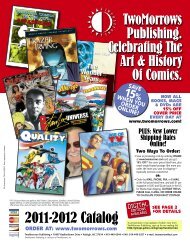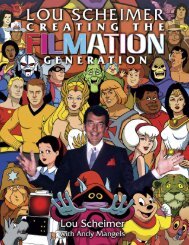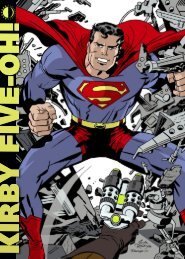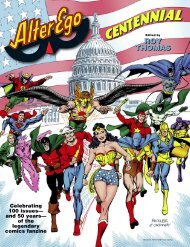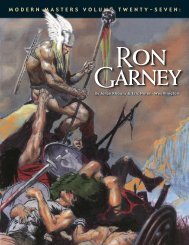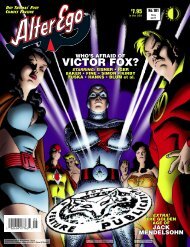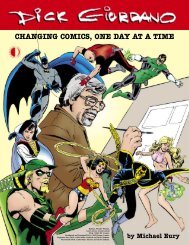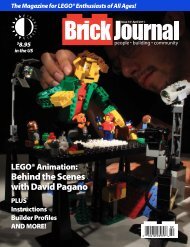Preview - TwoMorrows
Preview - TwoMorrows
Preview - TwoMorrows
Create successful ePaper yourself
Turn your PDF publications into a flip-book with our unique Google optimized e-Paper software.
TM & ©2012 Marvel Characters, Inc.<br />
What’s The<br />
Point<br />
While Captain America was not the first patriotic<br />
superhero, he quickly became the most popular.<br />
The cover of Captain America Comics #1<br />
expressed a widely held, but largely unspoken,<br />
sentiment in the U.S. at the time—recall that the<br />
issue debuted months before the bombing of Pearl<br />
Harbor and the country’s formal entry into World<br />
War II. But while the original design for Captain<br />
America was by Joe Simon (see his original sketch at<br />
right), Jack Kirby became more associated with the<br />
character and returned to detailing his exploits<br />
several times throughout his career. Jack remained<br />
remarkably (for him) consistent in how he drew<br />
Cap, but he did make several design changes to the<br />
iconic shield, most of which have gone unnoticed.<br />
The original shield design, by Simon, was<br />
largely triangular in shape, with a scalloped top. It featured three<br />
stars and seven red, white and blue stripes. The splash page of that<br />
first issue sports what is basically just a somewhat tighter version of<br />
Simon’s original sketch. Though the number of stripes varies a bit<br />
throughout the first issue, Jack generally kept things consistent.<br />
The first issue of Captain America Comics was wildly popular<br />
and garnered a lot of attention—including from John Goldwater, the<br />
dominant partner in MLJ Publications (now known as Archie<br />
Comics) whose<br />
own patriotic<br />
hero, The<br />
Shield, had<br />
debuted a year<br />
earlier. Simon<br />
notes in his<br />
autobiography<br />
that Goldwater<br />
was “admittedly<br />
upset that<br />
Captain<br />
America had far<br />
surpassed his<br />
hero” and he<br />
objected to the<br />
shape of Cap’s<br />
shield because<br />
he felt it was too<br />
similar to The<br />
Shield’s chest<br />
insignia. Martin<br />
Goodman, who<br />
Incidental<br />
Iconography<br />
An ongoing analysis of Kirby’s visual shorthand,<br />
and how he inadvertently used it to develop his characters,<br />
by Sean Kleefeld<br />
30<br />
Of A Round<br />
Shield?<br />
published Captain America Comics, was leary of legal<br />
action. Simon quotes him as saying, .”.. lawsuits are<br />
expensive and we’d better go over there to talk to<br />
him.” To avoid a lawsuit, they agreed to change the<br />
shield to a circular design.<br />
(Interestingly, they found themselves in<br />
Goldwater’s offices again the following year when he<br />
threatened to file suit over a villain in Captain America<br />
Comics #6 called The Hangman, feeling it infringed<br />
on the MLJ character of the same name. That<br />
Goodman backed down a second time and promised<br />
to never use the character again speaks volumes to<br />
the relationship between the two publishers.)<br />
What seems to go unnoticed by many fans,<br />
however, is that the convex circular shield that<br />
debuted in Captain America Comics #2 is not the<br />
same design they’re familiar with. Throughout Jack’s work on the<br />
stories in the 1940s, he drew Cap’s shield with two red bands and<br />
two white bands. All of the shield artwork after the company<br />
became formally known as Marvel in the 1960s displays two red<br />
bands and only a single white band. A minor distinction, perhaps,<br />
but it does have an impact on the overall visual.<br />
The round shield became more of an offensive weapon as well.<br />
Cap does backhand one crook with the triangular shield in his first<br />
issue, but the shield was largely incidental in that fight; Cap’s fist<br />
would have been there if the shield wasn’t. With the round shield, he<br />
begins to use it as a battering ram and large, blunt object, eventually<br />
throwing it for the first time in Captain America Comics #4. It’s<br />
thrown a second time in #6, and becomes something of a regular<br />
tactic beginning in #8.<br />
Jack came back to Captain<br />
America in the 1960s in the<br />
pages of Strange Tales. In issue<br />
#114, a villain called The<br />
Acrobat poses as Cap using a<br />
three color band shield. As<br />
noted at the end of the story, it<br />
was a test to see if fans wanted<br />
a return of the original character,<br />
who later made his famous<br />
return in Avengers #4. In both<br />
Strange Tales and Avengers,<br />
while readers see a three-colorband<br />
shield for the first time,<br />
it’s still not what they’re likely<br />
most familiar with. Unlike the<br />
four-color-band shield from<br />
TM & ©2012 Marvel Characters, Inc.



